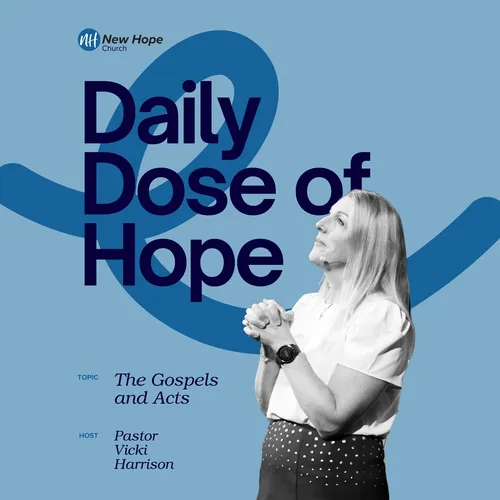August 4, 2025; Luke 3
- Author
- Rev. Vicki Harrison
- Published
- Mon 04 Aug 2025
- Episode Link
- https://sites.libsyn.com/240911/august-4-2025-luke-3
Daily Dose of Hope
August 4, 2025
Scripture – Luke 3
Prayer: Almighty God, Thank you for today and new week. Thank you for providing for us, caring for us, and protecting us. Over thousands upon thousands of years, you have taken care of your people. We give you glory and praise, for who you are. Thank you, most of all, for sending Jesus, who moved into our neighborhood so that we could begin to understand your love. Wow. There are no words to adequately thank you for the sacrifice that saved our lives. Lord Jesus, we love you and we thank you. Help us grow in holiness, continue to transform us so we can be a better reflection of you. In Your Name, Amen.
Welcome back, everyone, to the Daily Dose of Hope, a deep dive into the Gospels and Acts.
Today, we dive into Luke 3. I find it particularly fascinating how Luke begins by listing all the rulers of the time. He is showing us that John and Jesus are doing ministry within a particular geopolitical landscape. Luke identifies some of the most important rulers of that region. Tiberius was the Roman emperor from 14-37 AD. Like many emperors, he was known to be cruel, corrupt, and self-obsessed. His rule served as a significant contrast from the kind of Kingdom ushered in by Jesus Christ.
Then we have Pontius Pilate. He was governor of Judea from approximately 26-37 AD. Of course, we recognize him for his role in Jesus’ trial and death, which also landed him a mention in the Apostles’ Creed.
Herod Antipas is also mentioned. He was the son of Herod the Great. The Herod dynasty was set up by the Roman government to rule over the Holy Land. They considered themselves Jewish, although the Jewish leaders might have argued that point. The Herods in general tended to feel easily threatened and rule with an iron fist. Herod Antipas was ruler over the region of Galilee and Luke refers to him a few times.
The high priests who Luke mentions are Annas and his son-in-law, Caiaphas. Caiaphas was officially the high priest during this time but the presence of Annas still was clearly felt.
Mentioning these real people was important to Luke. He wanted to show that God is bringing about salvation not in the abstract but in real time, through real events, real people, and in actual places. It’s in the messy, difficult, and complex event of history that God reveals himself and continues his work of redemption.
And the work starts with John the Baptist, who gathers people in the wilderness at the Jordan River. He quotes some prophecy from Isaiah, suggesting that God’s people will be restored among the nations (of course, no one quite understands how they will be restored.) And of course, John talks about Jesus, for whom he has been called to prepare the way. John is a forerunner of sorts, preparing the hearts of the people for what is to come. John has no problem speaking truth, he has some pretty harsh words for the people, calling them to repentance and baptism. Keep in mind, repentance means a sincere turning away from sin and a turning toward God. This is more than just being sorry. It is a real change of heart and mind with a desire to be obedient. John addresses the common people, the soldiers, and even the tax collectors, and how they can repent and begin to produce good fruit.
When John baptizes Jesus, it marks the beginning of Jesus’ public ministry. This call to ministry was accompanied by the Holy Spirit in the form of a dove and confirmed by God’s voice from heaven. It is a beautiful picture of the Trinity. What’s interesting and even a bit puzzling about this scene is that John’s baptism, as I just mentioned, was one of repentance. It was for sinners to come, repent, and be cleansed. But Jesus was sinless. He had no need of a sinner’s baptism. And yet, he chose to go through the ritual. Jesus sought to identify with the people he came to save.
This is a critical part of the incarnation, God coming to earth to become a human being. It’s in the incarnation that Jesus becomes one of us. Jesus goes to the people, identifies with them, and gives them a real-life demonstration of who God is and how much God loves them. The baptism was simply the beginning.
The chapter closes with a genealogy of Jesus, according to Luke. Luke attempts to trace Jesus’ family tree all the way back to Adam. While Luke isn’t literally listing every single generation, he is making a point. Jesus did not come to just save the Jewish people but all people. We know from the book of Romans that Paul calls Jesus the new Adam, the one who restored what was lost in Adam’s sin. While Adam infected all people with sin, Jesus opened the door to redemption and eternal life for all people who believe in him.
Take a moment and read through this genealogy again, as well as the genealogy in Matthew 1. What are the similarities and differences? How does each author go about telling the story of Jesus’ family?
More tomorrow.
Blessings,
Pastor Vicki
